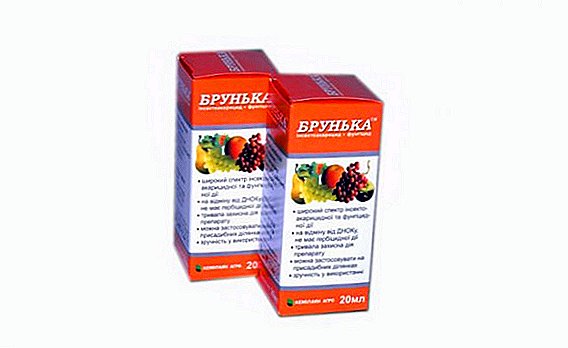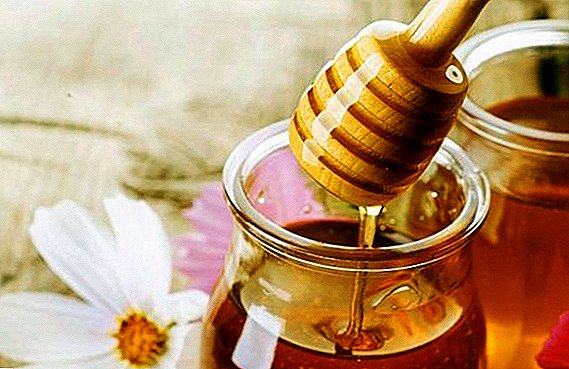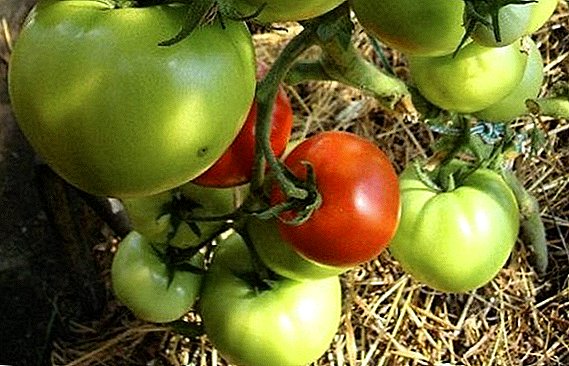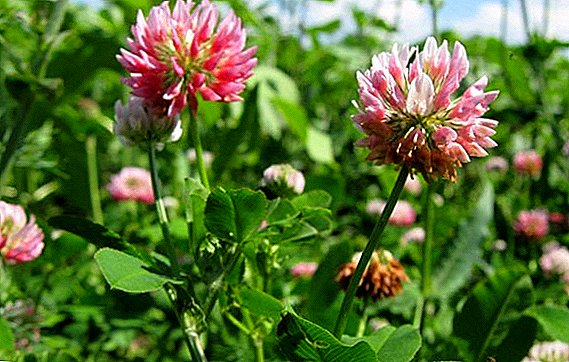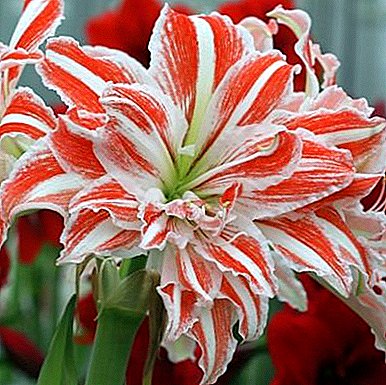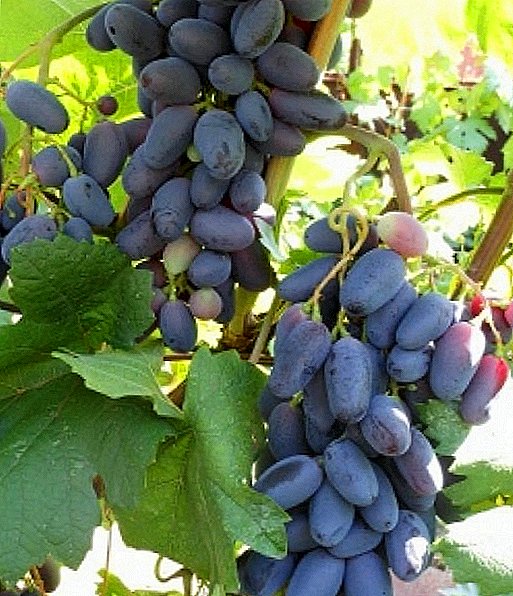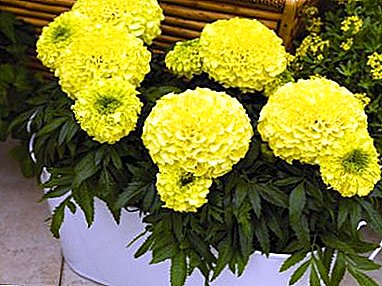
One of the most popular ornamental plants are marigolds. Compact bushes, full blooming all summer orange or red flowers, are found in parks, alleys and gardens.
The peculiar smell of marigolds repels many insects, but there are pests that live and feed on flowers. Folk recipes and chemicals will help protect the flowerbed. The article will look at how to process flowers from spider mites, aphids and other insects, as well as how to treat diseases.
Briefly about the plant
Annual and perennial flowering plants of the Aster family in Russia are called “marigolds”. The scientific name is Tagetes. In Europe, flowers appeared in the XVI century, arriving in the Old World from America on the ships of the conquistadors. Over the centuries of work, breeders have bred about 60 varieties and marigold hybrids. The long flowering and unpretentiousness of the plant made it popular among gardeners. Learn more about marigold varieties, as well as see the description and photo of flowers here, and about the features of caring for a stunted view, read here.
Marigolds - bushes with erect stem, pinnately dissected leaves of various shades of green and bright inflorescences. Culture height from 20 to 100 cm. Three main types of taggetes are grown in decorative floriculture:
- rejected;
- erect;
- thin-leaved.
Learn how to grow upright Erect, Thin-leaved, Rejected species of marigolds in open ground, as well as get acquainted with the photo of flowers here.
Derived marigold varieties with chrysanthemum, double and semi-double flowers. Coloring hybrids is white, yellow, orange, red or two-color.
Diseases and their treatment
Caring for marigolds is simple, but if the recommendations on planting density and moisture are violated, the flowers are affected by fungal infections.
Blackleg
 The most common problem of seedlings Tagetes - the appearance of dark rotting spots at the bottom of the stem. This is a fungal infection called blackleg.
The most common problem of seedlings Tagetes - the appearance of dark rotting spots at the bottom of the stem. This is a fungal infection called blackleg.
Diseased plants are destroyed. Healthy seedlings transplanted to another soil, pre-treated with a fungicide.
For the prevention of the disease, the seeds of the plant and the soil before planting are treated with a fungicide, a chemical substance that destroys the fungus.
Root rot
Problems with the roots affect the appearance of the plant. It withers, turns yellow, then dies. There is no cure. To prevent damage to root rot allows compliance with agrotechnology - planting flowers in loose soil, moderate watering. It is impossible to feed seedlings with fresh manure. This season and next year it is not necessary to plant plants in the infected area.
Viral diseases
Signs of viral infection of marigolds are manifested in the form of deformation of leaves and buds, the absence of seeds, yellowing of the stems. On the leaves appear black spots and patterns of bronze color. The disease can begin at any stage of development.
Important! Plants with the listed symptoms are pulled out and destroyed.
Pests - photo, description and control measures
Rows of fragrant marigolds often appear in vegetable beds. Flowers are planted not for decorative appeal, but as a means of repelling pests. They are avoided by onion flies, weevils, and polar bears. Not all insects are afraid of phytoncides secreted by the plant.. Some pests inhabit the marigold bushes, destroying the decorative appeal of flowers. Below, we will tell and show who eats the stems and eats the leaves of this plant.
Aphid

The body size of the aphids is 3-7 mm, its head is equipped with a proboscis, capable of piercing the leaves and stems to feed the plant sap. Insects live in huge colonies that oppress the development of flowers. Aphid excretions attract other insects and contribute to the appearance of fungal infections.
How do gardeners deal with annoying aphids? Aphid insecticides have active ingredients that cause rapid paralysis and death of insects. After processing, they enter the body of the pest along with the plant sap. Protective action lasts up to three weeks. Among the effective drugs: "Spark", "Aktara", "Fufanon." You can process the flowers with the biological means "Fitoverm". It is used for marigolds in open field and greenhouse.
Slugs and snails

In rainy summer slugs and snails appear in dense thickets of taggettes. It is difficult to find them, mollusks appear at night. The consequences of their nutrition are holes in the leaves, damaged stems. Young annual flowers are particularly affected. Identify the enemy can be on the paths of dried mucus.
Tip! The best way to fight clams is to set up traps. Next to the flowers lay the boards, pieces of plywood or burlap, cabbage leaves. Under these objects in the afternoon slugs will hide. Raising shelter, they are collected and destroyed.
The granulated preparation "Thunderstorm" will help to solve the problem quickly. When scattering it is important to take care of the protection of the respiratory tract. Slugs and snails are scared away by mustard powder, infusions of onion and garlic, applied to the stems and leaves of the plant.
Thrips

Small insects of 1-2 mm in size are well known to flower growers. They not only suck the sap of plants, but also spread diseases. Thrips lurk in the marigold buds, where it is quite difficult to find them. On the presence of pests say punctures on the petals, deformation or abscission of flowers. The peak of distribution falls on hot dry days, when a new generation quickly emerges from the eggs laid.
Tagetes can be saved from pests by systemic insecticides. At the first symptoms of infection, a solution of special preparations "Karate", "Intavir", "Aktellik" is prepared. Means are diluted in water according to the manufacturer's instructions. Spraying the flowers is done in the morning or in the evening in calm weather.
Spider mite

The small arthropod is active in dry hot weather. The first mite infects young seedlings grown indoors. But with a lack of watering, he appears on adult plants. Characteristic signs of a pest attack are:
- the appearance of light spots on the leaves;
- weaving of the affected areas with thin cobwebs;
- drying of damaged leaves (for details on marigold dries and what to do with it, read here).
The size of the pest is 0.6-1 mm. Spider mites live in colonies, hiding on the back of the leaves. Adults and their offspring pierce the tissues of marigolds and feed on sap. When the population grows, the pests are selected on the flower tops, creating a web between the stems. Weakened plants become vulnerable to viruses and diseases.
The first thing to do when a web is found, wash the plant with water from a hose. This will allow to wash away some of the pests and increase humidity.
Garlic infusion will help to get rid of the tick (200 g of the product per 1 l of water), 5 ml of the concentrate is diluted with 1 l of water.
Arthropods can not stand the smell of tobacco. From its leaves (250 g), laundry soap (50 g) and 3 liters of water, prepare an infusion. After 2-3 treatments, the pests disappear.
Chemical products are the quickest to get rid of spider mites. "Antikleshch" - a specially developed tool based on malathion. The action of acaricide appears after a few hours, it can be applied in hot weather. No less effective drugs are "Apollo", "Akarin", "Neoron".
Caterpillars

Eaten green leaves are traces of the impact of caterpillars. Having settled on the site, the faces of butterflies feed on various greens, without neglecting marigolds. Damaged flowers lose their decorative appeal.
Help destroy the pest means entero-contact action "Arrivo", "Akarin." A solution of chemicals sprayed on the flowers. It enters the body of the caterpillars with food. Pests die in a few hours.
Preventive measures
Flowering period of marigolds falls on the hottest months of summer. (to see how the flowers look in the photo, as well as to find out why the plant does not dissolve the buds, here). To avoid problems with spider mites and thrips, you need to regularly water and spray the plants with water. A sufficient level of moisture prevents the appearance of pests.
In order to prevent diseases and the appearance of pests, the following actions are recommended:
- Timely weeding and loosening the land between the bushes of marigolds.
- Removal of dry and infected buds.
- Compliance with watering.
- The introduction of one or two phosphorus-potassium fertilizing for the season (more about how to feed the "Chernobrovtsy" for abundant flowering, you can find here).
Recommendation. Autumn grounding of shredded bushes of an annual taggetes into the soil prevents the development of fungal infections.
More on how to protect your favorite marigolds from diseases and pests, we told in this material.
In the stems, roots and leaves of marigold contain active substances - phytoncides, to avoid most of the disease. Proper care of flowers, compliance with the recommended mode of watering allows you to keep the plants beautiful and healthy. Planting tagetes in the garden in the garden helps protect vegetables from various pests, including nematodes.


